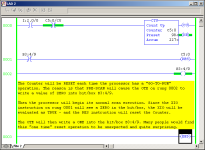Ron Beaufort
Lifetime Supporting Member
sudden thought:
is there an OTE instruction for B3:4/9 anywhere in the program? ...
if there is, and IF (that's a big IF) the processor happened to transition into a "GO TO RUN" condition, then PRE-SCAN would have written a ZERO status into bit/box B3:4/9 – and this would have happened before the processor made it's first pass through the logic ... and it would have happened REGARDLESS of the logic (true or false) which normally controls the status of bit/box B3:4/9 ...
so ...
if the logic which normally controls bit/box B3:4/9 happens to be located AFTER the counter reset rung, then the XIO for B3:4/9 would have been evaluated as TRUE on the processor's first pass ...
this could account for an unexpected RESET of the Counter ...
is there an OTE instruction for B3:4/9 anywhere in the program? ...
if there is, and IF (that's a big IF) the processor happened to transition into a "GO TO RUN" condition, then PRE-SCAN would have written a ZERO status into bit/box B3:4/9 – and this would have happened before the processor made it's first pass through the logic ... and it would have happened REGARDLESS of the logic (true or false) which normally controls the status of bit/box B3:4/9 ...
so ...
if the logic which normally controls bit/box B3:4/9 happens to be located AFTER the counter reset rung, then the XIO for B3:4/9 would have been evaluated as TRUE on the processor's first pass ...
this could account for an unexpected RESET of the Counter ...





